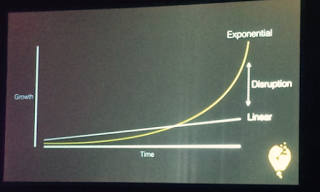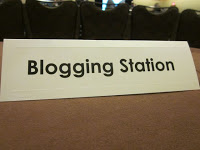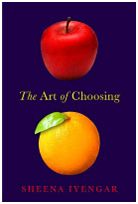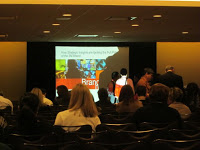TMRE 2011 Live
Live from TMRE 2011: Learnings from Coca Cola, Henkel, Mars Pet Care and 3M

Yes of course, putting famous brands in the headline always is a good
idea... But today I learned how to choose... ;-)
idea... But today I learned how to choose... ;-)
The second day of this year's The Market Research Event is nearly over and
I have to say it was very inspiring as well as educational to a certain extent.
I have to say it was very inspiring as well as educational to a certain extent.
Everything started with the keynote sessions and a session I had really
looked forward to: "The Art of Choosing" by the impressive Sheena
Iyengar.
looked forward to: "The Art of Choosing" by the impressive Sheena
Iyengar.
"Be choosy about choosing" was the summary of it all. But before
coming to this final recommendation she was takling about one of the most
relevant problem in everyday life consumption of any goods. How do people
choose and how could choosing be simplified. If you are more familiar
with "the narrowing down problem" by Fidelity research or the
"3 by 3 rule" by McKinsey, you know what Sheena was talking
about.
coming to this final recommendation she was takling about one of the most
relevant problem in everyday life consumption of any goods. How do people
choose and how could choosing be simplified. If you are more familiar
with "the narrowing down problem" by Fidelity research or the
"3 by 3 rule" by McKinsey, you know what Sheena was talking
about.
In her own words she was talking about the "jam problem". She
showed some of her experiments and one was about jam. Draeger's Grocery Store
for instance has a huge variety of options to choose between all kinds of
products, besides others 348 different kinds of jams. The question is, is it
useful to have that large variety of options? To test this in the experiment
she tested two stands, one with 6 jams and one with 24 jams. At the booth wit
24 jams 60% stopped, at the both with 6 jams 40% stopped. But only 3% bought
something at the 24 jam stand and 30% bought something at the 6 jam
stand. So it was more than 6 times more likely to buy jam if 6 jams were
offered than 24 jams. The number of choices is attracting but the choice itself
is much more difficult.
showed some of her experiments and one was about jam. Draeger's Grocery Store
for instance has a huge variety of options to choose between all kinds of
products, besides others 348 different kinds of jams. The question is, is it
useful to have that large variety of options? To test this in the experiment
she tested two stands, one with 6 jams and one with 24 jams. At the booth wit
24 jams 60% stopped, at the both with 6 jams 40% stopped. But only 3% bought
something at the 24 jam stand and 30% bought something at the 6 jam
stand. So it was more than 6 times more likely to buy jam if 6 jams were
offered than 24 jams. The number of choices is attracting but the choice itself
is much more difficult.
In another experiment people were asked to choose chocolate, one group out
of 6 pieces and another out of 30. At the end they could rather have money or
chocolate for incentive. Chocolate choosen from the 30 piece deck was perceived
as less delicious and people tend to take the money more often than the
product.
of 6 pieces and another out of 30. At the end they could rather have money or
chocolate for incentive. Chocolate choosen from the 30 piece deck was perceived
as less delicious and people tend to take the money more often than the
product.
This leads to three different negative consequences for brands and
products:
products:
1. Commitment - The
number of choices weakens the commitment toward the choice anyway, even if it
is important to consumers
number of choices weakens the commitment toward the choice anyway, even if it
is important to consumers
2 Decision quality - The more
choices they have, the lower the perceived quality of the decision
choices they have, the lower the perceived quality of the decision
3 Satisfaction - The more
choices they have, the less satisfied they are with their choice they made
choices they have, the less satisfied they are with their choice they made
But why is this?
We have cognitive limitations, the modern world is designed for experts who
knows how to skip suboptimal options.
knows how to skip suboptimal options.
Options are more and more indistinguishable. Differences are to small but
variety is often seen as a competitve advantage, no matter how small the
differences are.
variety is often seen as a competitve advantage, no matter how small the
differences are.
And there is more pressure to choose anyway. Because we aspire to be unique
(but not extraordinary). And our choices express our personality. We think:
"If I choose this what does this say about who I am and what I want and
how does the choice reflect on what I want and who I am..."
(but not extraordinary). And our choices express our personality. We think:
"If I choose this what does this say about who I am and what I want and
how does the choice reflect on what I want and who I am..."
So it is all about offering a better choosing experience!
And there are three techniques to deliver this:
1. cut - retailer ALDI ist probably the best example to express what sheena
means with "cut"
means with "cut"
2. categorize - look at Best Sellers and they categorization of wine to get
an idea what's behind this
an idea what's behind this
3. condition - start easy with complex choices and slightly increase
complexity within the process of choice
complexity within the process of choice
The next one was a good experience. I was sitting at the bloggers' desk and
was glad to have a seat.
was glad to have a seat.
The room was crowded, first time at TMRE in the session I attended. Diane
Hessan and Stan Sthanunatahn were there to talk about Market Researchers in the
21st century. Amazing, they only showed one chart, and this was the title ;-)
Hessan and Stan Sthanunatahn were there to talk about Market Researchers in the
21st century. Amazing, they only showed one chart, and this was the title ;-)
So it was more an interview than a track session, but very interesting to
hear a big company's perspective on the future needs of our industry. Want to
read some quotes? Here you are:
hear a big company's perspective on the future needs of our industry. Want to
read some quotes? Here you are:
"Market research is the best profession in the world, because it is at
the heart of every important decision"
the heart of every important decision"
"But the best
profession is also boring, because parts of the jobs are boring. Processes are
designed to be boring"
profession is also boring, because parts of the jobs are boring. Processes are
designed to be boring"
"Challenge is inspiring
people. Be a change agent."
people. Be a change agent."
"Surveys may not always
be the truth, and why would you tell the truth to a complete stranger?"
be the truth, and why would you tell the truth to a complete stranger?"
"What makes Coke so
successful? Not just the tv commercials, but the "strong community
connections"
successful? Not just the tv commercials, but the "strong community
connections"
"brand health can't be
developed in a month, why measure it on a monthly base?"
developed in a month, why measure it on a monthly base?"
"Synthesize your findings
into an informed dream of the future"
into an informed dream of the future"
"Take the familiar and
make it unfamiliar. Convey facts in a different way to inspire"
make it unfamiliar. Convey facts in a different way to inspire"
Nothing to add at this point
:-)
:-)
Then I attended a session from the Marketing & Brand Insight
track and one from the Activating Insights track.
track and one from the Activating Insights track.
Ann Bearth was talking about 3M and the efforts they made by reactivating
the brand. Quite interesting to see what barriers to overcome internally and
how to roll out a real huge internal and external survey. One of the most
interesting findings to my point of view was the fact that younger employees of
3M are more engaged in the brand, for customers the opposite is true.
the brand. Quite interesting to see what barriers to overcome internally and
how to roll out a real huge internal and external survey. One of the most
interesting findings to my point of view was the fact that younger employees of
3M are more engaged in the brand, for customers the opposite is true.
And that brand activation can be ensured by sharing the stories of the
companies and their brands, internally and externally.
companies and their brands, internally and externally.
Henkel also found a great internal experience to bring insights to life.
They decided to have an internal live event in order to let the consumer speak
and to show the employees their work in order to use their power and ideas to
develop new ways of increasing usage of the prodcts the compay sells. All in
all it was an intense experience for them.
They decided to have an internal live event in order to let the consumer speak
and to show the employees their work in order to use their power and ideas to
develop new ways of increasing usage of the prodcts the compay sells. All in
all it was an intense experience for them.
But Heiko Schfer also pointed out waht you have to keep in mind when doing
this kind of internal event. Some very valuable pieces of advise:
this kind of internal event. Some very valuable pieces of advise:
- Identify important business topics
- Set and track the event against clear objectives and KPIs
- Plan ahead and don't underestimate the time and effort required
- New skills are required
- Make it big
- Engage your audience
- Make it fun
But don't stop at the end of a one-shot. Make it a process and show your
skills.
skills.
Be out in front and lead.
This indeed was an encouraged speech about the current and future role of
market research in companies and for agencies.
market research in companies and for agencies.
Personally I have to say TMRE doesn't mean "too much really enough"
About the author: Christian Dssel is blogging about market research in German language here and here.
After having worked for TNS, TBWA and other strategy and market
research agencies he now holds the position of Senior Research Director
at MM-Eye in Hamburg / Germany with special responsibilities for MM-Eye's new media and online research approaches.




